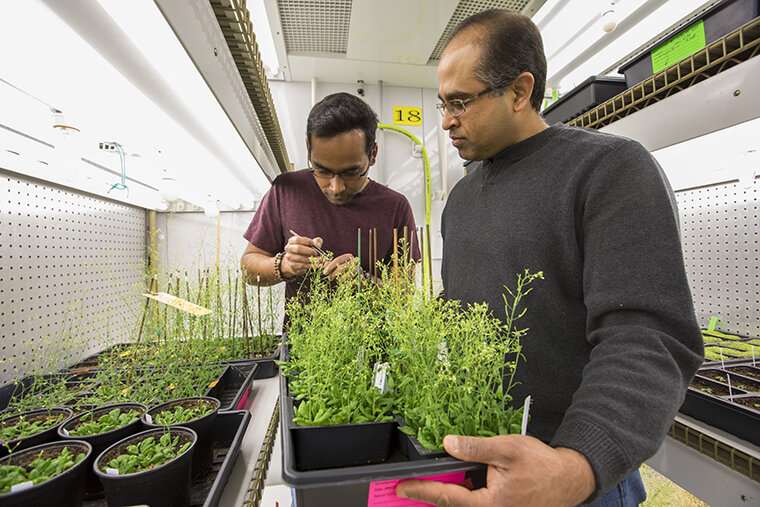How to build better highways in plants

As a plant grows, it moves cellular material from its version of manufacturing sites to the cell wall construction zone. Transporter proteins, called motor proteins, are thought to move these cell wall cargo via a complex highway system made up of microtubule tracks. The position of these tracks must be stabilized so that cargo are delivered to the correct locations.
This microtubule track system beneath the plasma membrane of plants has been a particular source of scrutiny for one biology laboratory at Washington University in St. Louis. The Dixit lab, which in a study published in 2018 found molecular brakemen that keep the Arabidopsis Fragile Fiber 1 (FRA1) motor protein in check, uncovered in continuing research that FRA1 cinches its track in place through cellulose synthase-microtubule uncoupling (CMU) proteins. The new research was published June 2 in The Plant Cell.
"If the FRA1 protein is absent, the microtubule tracks become floppy and detach from the plasma membrane," said Ram Dixit, associate professor of biology in Arts & Sciences and co-director of the plant and microbial biosciences graduate program, "and there goes an orderly highway system and mode of navigation."
While searching for cargo proteins that interact with the tail —or cargo-binding—region of the FRA1 motor protein, the researchers found that CMUs interact directly with this region of FRA1. CMUs were known to bind to microtubule tracks and guide the movement of transmembrane cellulose synthase complexes that produce one of the major cell wall components, cellulose. In the absence of CMUs, motile cellulose synthase complexes cause normally straight microtubule tracks to bend and undulate, disrupting cell wall construction.
The team discovered that interaction with FRA1 impacted the positional stability of the tracks through regulating the levels of CMU proteins by preventing CMU protein degradation and maintaining their presence on microtubule tracks. The researchers found that phosphorylation of the tail region of FRA1 inhibits its interaction with CMUs, which provides plant cells a way to control CMU levels and thereby track stability.
The researchers performed genetic experiments that demonstrated the significance of this interaction to the reproduction and growth of Arabidopsis plants. Dixit was the study's senior author along with co-authors Anindya Ganguly, Chuanmei Zhu and Weizu Chen.
"We found that CMU1 and CMU2 have distinct functions," Ganguly explained, "with CMU1 being a major factor in seedling growth and CMU2 being important to inflorescence stem growth in adult plants."
In the Dixit lab's continuing scrutiny of this transport system, researchers are interested in understanding whether CMU1 and CMU2 affect FRA1's ability to bind to cargo and if they compete for binding to FRA1.
"Our work flips the paradigm of microtubule-associated proteins regulating the activity of motor proteins," Dixit said. In a cell, microtubule tracks are studded by many different proteins. Some of them recruit motor proteins to promote transport while others act as obstacles that impede transport. While CMUs directly bind to microtubules, the researchers found that their absence does not alter the abundance or transport activity of FRA1. Instead, the FRA1 motor controls how much CMU is around to bind to and stabilize microtubules.
"Sometimes, a wandering path is not a good thing," Dixit said, "and our work reveals how a motor protein helps to keep its own track in place."
More information: Anindya Ganguly et al. FRA1 Kinesin Modulates the Lateral Stability of Cortical Microtubules Through Cellulose Synthase-Microtubule Uncoupling Protein, The Plant Cell (2020). DOI: 10.1105/tpc.19.00700
Journal information: Plant Cell
Provided by Washington University in St. Louis





















